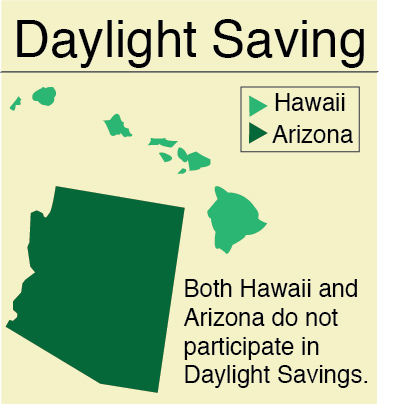Clocks will spring forward before the University takes spring break, as daylight saving time begins Sunday.
Setting the clocks one hour ahead can contribute to the loss of an hour of sleep Sunday night, but the time shift causes the sun to set later in the day. This change provides more daylight at the end of the day during the spring and summer months.
Bart Elmore, an assistant professor of American history, bikes to campus from Northport. He said he is happy to have more light at the end of the day in the spring because it makes his ride home a lot safer.
“In the automobile nation we live in today, these concerns may not matter to many folks,” he said. “But they certainly make a difference for us who use the energy in our bodies to get to and from work.”
According to the United States Naval Observatory, the history of daylight saving time began after standard time zones were instituted by the railroad industry, when the Standard Time Act was enacted into U.S. law in 1918. The act established daylight saving time but was later repealed in 1919. It was re-established nationally during World War II, but in 1966 the Uniform Time Act allowed states exemption from its observance.
Since 1966, Congress has enacted several different starting and ending dates, but since 2007, the time shift begins on the second Sunday in March and ends on the first Sunday in November.
Christopher Lynn, a professor and director of the evolutionary studies program in the department of anthropology, said daylight has a direct effect on human bodies but in today’s society daylight saving time is no longer beneficial.
“All over the world, people draw shades to ensure privacy and turn on electric lighting to make up the difference,” he said. “In Alabama, especially in the summer, we’re more concerned with regulating temperature and running air conditioners than conserving natural daylight.”
Lynn said North Americans especially schedule their lives around demanding work and school deadlines rather than the body’s natural circadian rhythms activated by daylight.
“We force ourselves up early, force ourselves to work through an eight-hour or so long day, caffeinate heavily to keep going despite flagging efficiency after lunch, then sit up by the fake glow of television and iPad screens,” he said.
Lynn grew up in Indiana, where daylight saving time was not established statewide until 2006. Hawaii and Arizona are the only states that do not currently observe daylight saving time.
There are 115 students from Arizona and 33 students from Hawaii at the University, according to the University’s Census Enrollment Report for Spring 2015. John-Cole Garwick, a sophomore majoring in economics and finance, is from Glendale, Arizona, and said he never changed his clocks for daylight saving time before coming to Alabama.
He said Arizona transitions between time zones instead of shifting the daylight twice a year. Pacific Standard Time is observed for half the year and Mountain Standard Time is observed during the other half.
“I don’t understand [daylight saving time],” he said. “The fact that twice a year I now have to move my clocks around an hour forward and an hour backward doesn’t make sense. You literally lose an hour out of your day.”
Garwick said changing the clocks freshman year was tough to remember for him and his roommates, who are also from Arizona.
“In the fall of freshmen year we didn’t change our clocks for probably a week,” he said. “The first day our phones changed because they do it automatically, but all the appliances and stuff inside our dorm just sat there.”









